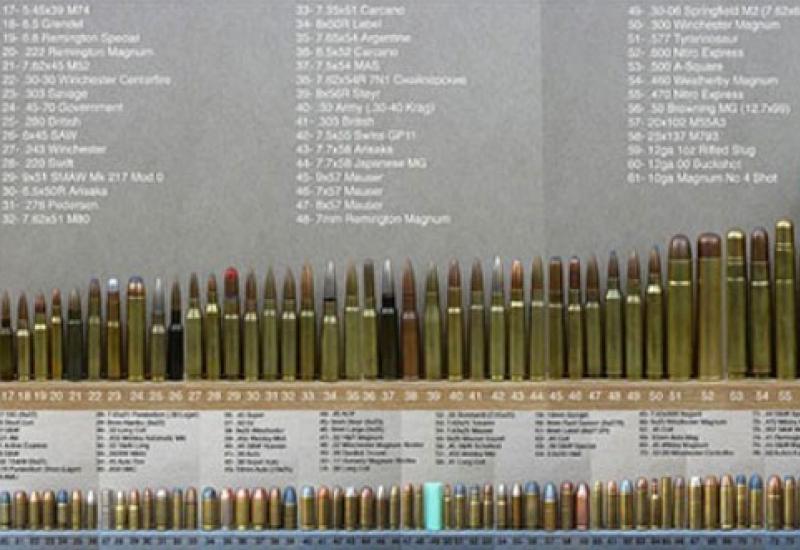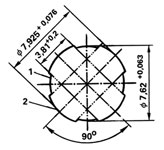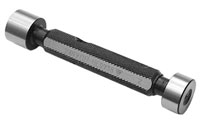At the mention of the word "caliber" the first thing that comes to mind, especially the stronger sex, it is one of the characteristics of small arms. And almost simultaneously in memory pops a magical combination of numbers and letters "7.62 mm", which means that the caliber of the representatives of the first family of automatic gun of the designer Mikhail Kalashnikov.
At the same time, try to ask someone to explain the term "caliber", and that someone will have to work hard to do it right, comprehensive and easy to understand: after all, for many members of certain professions caliber - is a term that is not related to the formidable weapons. So what is the caliber?
First of all, this is one of the basic characteristics of small arms and artillery weapons. The word "caliber" came to us from the Arabic qalib and Italian calibro (shape, pattern), which in turn derives from the Greek word kalapous, which means shoe lasts, that is the form for the manufacture of footwear.
All firearms barrel channel type is divided into threaded, in that the bore has a screw thread adapted to the bullet during the flight of a rotating motion, and smooth that has no cuts in the trunk.
The cut weapon provides better accuracy, range and flat trajectory of a bullet. In this case, screw-thread of the bore is characterized primarily by the diameter in the fields and thread, depth, width and pitch of grooves (the length over which the rifling make a full turn). When a bullet moves in the barrel rifling field cut into its shell (or shell of the ball crashes into the rifling), which provides a pool with rotational motion, so that the bullet is stable during the flight, and meet the target with its top part. Step grooves, their number and the shape depends on the speed, size and length of the bullet, as well as the material of the surface layer of the bullet.The most widely used is right cutting (as viewed while moving bullet, it rotates clockwise, that is, from top to bottom right).
The size of the barrel is characterized primarily by the caliber and length (which, in turn, especially for artillery systems are often measured in calibers).
Shotguns calibers from the 4th to the 32th are designated by the number of spherical bullets cast from an English merchant pound of lead (453.59237 g). So, if from a pound of lead it is obtained 12 spherical bullets, then the gun will be 12th caliber, etc. It is understood that the diameter of the bore 4 gun caliber gun is larger than the diameter 32-caliber (about 23.5 mm and 12.7 mm, respectively, values are about as they depend on the quality class of the barrel, the manufacturing plant, and the type of equipment used for cartridge cases - metal or paper).
Calibers rifles represent millimeters, lines and inches. Knowing that 1 line = 2.54 mm and 1 inch = 25.4 mm, it is easy to understand the designation of caliber rifles.
The famous trilinear rifle Sergei Ivanovich Mosin has caliber 3x2,54 mm = 7.62 mm. Since the calibers are usually denoted USA hundredths of an inch (or points: 1 point = 0.254 mm), and in the UK - in mils, the American caliber 30 is multiplied by 0.254 mm, 300 caliber English - at 0.0254 mm. In these cases, we obtain 30x0,254 mm = 7.62 mm and 7.62 mm = 300x0,0254 mm.
Thus, the line calibers 3, 7.62 mm, 30, and 300 equal to each other simply expressed differently. Another widespread caliber small-caliber weapons ("small caliber" - less than 6.5 mm) is denoted respectively 2.2; 22; 220 and 5.6 mm.
In different countries, the diameter of the rifle as measured by the cuts, and by the fields. Therefore, the same caliber can be noted in different ways. Thus, in the 5.6-mm caliber rifles, it is sometimes referred to 5.45 mm (measured by slicing and fields, respectively). The situation is similar with 7.62 mm in Germany this caliber 7.92 mm is indicated. Thus, the bullets pistol cartridge 9 mm caliber, designed for the domestic arms (outer diameter 9,2 mm), totally unsuitable for Western models of weapons (outer diameter 9.0 mm).
In rifled artillery caliber indicate similar designation of small arms, and smooth-bore (the seventeenth-IX in.) - On the mass of the cannonball, for example, a 12-pound cannon (≈122 mm), 5 pounds of mortar (≈333 mm).
It is assumed that the small arms firing bullets and artillery - shells. Although there is no a common agreement in this matter so far. For example, before 1914 in Russia and some other countries shell weighing less than one pound (409.51241 g) was considered a bullet, from pound to pud (16.380496 kg) - grenade and more than one pud - bomb. Later a bullet and a shell started to be distinguished by a method of connection with the rifling of the barrel, but not by weight believed that the bullet cuts into the shell, the shell and - a leading belt (annular projection formed of a relatively soft material such as copper or polymer). Also there is a classification according to which the bullet might be 20 mm caliber, the projectile and - 20 mm and more.
Today, the term "bullet" is used primarily for small arms, the term "grenade" was fixed for hand grenades and ammunition for grenade launchers, "bomb" - by aerial bombs and artillery shells began to be called simply "shells".
Caliber another type of ammunition - Marine torpedoes - also referred to in millimeters or inches. The most common size is 533 mm torpedoes (actually 533.4 mm) or 21 inches. Also it is useful torpedo diameter 254 mm (10 inches) to 660.4 mm (26 inches).
Caliber bombs is the average weight of the bomb to determine its size. Domestic industry mastered such caliber bombs: 2.5; 5; 10; 15; 20; 25; 50; 100; 250; 500; 1000; 1500; 3000; 5000; 9000 kg. If the actual weight of the bomb does not coincide with its caliber for the data size, the weight of the bomb is indicated in the name after the numbers indicating caliber. For example, SAB-50-15 means: Lighting bomb caliber 50 kg and 15 kg.
For machine builders the term "caliber" is more peaceful value. For them, the caliber - it unscale measuring instrument designed to control the size, shape and arrangement of the workpiece surface.
We differentiate between normal and limit calibers. Normal size (template) is used to test complex profiles. Limited caliber has checkpoint and impassable side (upper and lower deviation of the nominal size) that allows you to control the size of a tolerance zone. Limited calibers are used to measure cylindrical, conical, thread and spline surfaces. Passing caliber is a prototype of the connection piece and controls the size of the entire length of connection forms for errors. Impenetrable caliber should control only the actual size of the parts and therefore is a little longer to eliminate the influence of form errors.
In the watch industry the caliber of a clockwork characterized landing size of platinum - the basis of the movement, on which are mounted all its parts (eg, bridges and support wheels, stones or hours). In this case, depending on the caliber watch mechanism is divided into small caliber watch - women's watches and clocks normal caliber - men wrist.
In round mechanisms caliber corresponds to bore diameter platinum and non-circular calibers mechanisms are in caliber round mechanisms according to the formula:
![]() , where S - area of non-circular platinum clockwork.
, where S - area of non-circular platinum clockwork.
Clocks are produces with the following calibers: 16, 18, 20, 22, 24, 26, 28, 30, 34, 36 and 40 mm (although exceptions are allowed: for example, hours "mate" with platinum has a diameter of 31 mm). Also available with a non-circular clock mechanisms have given calibers 13, 15, 17 mm, and a few others.
Caliber hours, made in Switzerland, usually are measured in lines.
It is interesting that, by analogy with the smooth-bore hunting weapon caliber also began to consider a number of elements in normalized units, such as the volume. Thus, in particular, define the caliber of vegetables, fruits (e.g. olives), seafood (e.g., shrimp), indicating packing. A special feature of this definition is that a smaller caliber, as in the smooth-bore hunting weapons, corresponds to larger units of production.
Likewise, in US it is measured the wire diameter. For example, since 1857 the United States used American wire caliber (American Wire Gauge - AWG), according to which the lower the number, the thicker the wire. Historically, the wire is made by drawing and its number (size) is the number of consecutive passes through a hole in decreasing the portage before we obtain the desired diameter of the finished product. For example, a thick (greater than 8 mm) 0 AWG wire only after 24 operations was converted to AWG 24 diameter of about 0.5 mm.
... As you can see, each known word "caliber" has several meanings: not only military but also purely peaceful. And it is higly desirable that it will be associated primarily with the beautiful and convenient clocks or delicious olives!
| Attachment | Size |
|---|---|
| calibre.gif (291 bytes) | 291 bytes |




